Last Updated: 02/06/2025
New Puppy Guide
Bringing home a new puppy and you don't know where to start? Take a read through our guide.
Author: Dr Teagan Lever BVSc (Hons)
Reading Time: 113 minutes - extensive read
Congratulations on adding a new furry friend to your family! Bringing home a puppy is an exciting adventure filled with joy and new experiences. Whether you're a first-time dog owner or have other pets, there are many things to consider to ensure your puppy has a smooth transition into your home.
If you're feeling overwhelmed or unsure about where to begin, our comprehensive new puppy owner checklist is here to guide you. We've compiled valuable information and tips to help you provide your puppy with the best possible start in life.
Our vets have also put together the top 10 frequently asked puppy questions and common mistakes that puppy owners make. And don't forget, we offer a free Vet Pet Plan service if you want some paw-sonalised product recommendations and extra puppy care advice!
Need new supplies for your puppy?
Check out our Better Puppy Bundle - a complete vet-approved puppy essentials pack, designed to help tick off your 'new puppy checklist'. It contains parasite prevention, toys, treats, training aids, food vouchers, and more!
This puppy bundle is available in different sizes - for small, medium, or large breed pups.
In this article
- Are you ready for a Puppy?
- New puppy shopping list
- Bringing home a new puppy
- How long do puppies sleep for?
- Microchipping and registering your puppy
- Puppy Vaccination Schedule
- Worming treatment for puppies
- Flea and tick treatment for puppies
- Desexing a Dog
- Puppy teething
- Pet Insurance - Is it worth it?
- Should your puppy come with genetic screening?
- When to take your puppy to the vet
- What to feed your puppy
- Feeding large and giant breed puppies
- How much to feed your puppy and how often
- Can I feed my puppy....? Dangerous foods for puppies
- Bathing and grooming your puppy
- Behaviour and training
- How to toilet train your puppy
- How to stop your puppy chewing everything
- How to stop your puppy biting
- Teach your puppy how to sit, drop, stay and walk on a lead
- Crate and clicker training basics
- Socialising your puppy
Are you ready for a puppy?

While the desire to hear the pitter patter of little puppy feet can be strong, it's important to pause and make sure that now is the right time. Puppies are a lot of work and you'll need plenty of patience and time to give them the best start in life.
Remember that a puppy is for life and that cute little ball of fluff will soon grow into an adult dog with a lifespan of 10 to 20 years!
Adopt, don't shop
Every year in Australia thousands of dogs and cats are surrendered to animal shelters and pounds, with many of these animals euthanized because a suitable home cannot be found.
Before heading to a pet store or breeder, consider whether you could instead offer a loving home to a puppy or adult dog in need. Dogs, puppies and other pets are available for adoption from the RSPCA, Animal Welfare League, PetRescue and other local rescue organisations. Take a look at our Dog Adoption Guide.
How to choose a dog breed that suits you
Wondering how to choose the best dog breed for your family? When choosing a breed, think about your home and lifestyle to determine what size and type of dog may be the best fit for you. If you have your heart set on a particular breed of dog, be sure to do your research before you commit. Purebred dogs in particular can be predisposed to a number of genetic health conditions and it pays to be well informed before you bring one home.
For more tips read How to Choose a Dog Breed That's Right for You.
Where to look and what to look for
If you choose to go down the route of obtaining your pup from a breeder, be selective about who you contact. Despite tougher regulations, puppy farms still operate in Australia and should be avoided at all costs. A puppy farm is a large scale breeding operation where large numbers of dogs are kept in inhumane, intensive conditions (eg. caged). Puppy farms are run purely with a focus on profit at the expense of the dogs' wellbeing and are widely condemned by veterinarians and animal welfare groups.
A responsible dog breeder will put the health and wellbeing of their breeding dogs first. They ensure that the dogs and pups are fed a good quality diet and kept up to date with all healthcare needs. Good breeders also screen dogs for any known inherited defects prior to breeding to avoid passing these on to the puppies.
Wherever possible if you are considering purchasing a pup from a breeder, ask to come and visit and meet them and the parents in person. Not only will meeting the parents and pups give you a better idea of their temperament, it will also allow you to gauge the kind of environment your pup is being bred and raised in.
When viewing a puppy, ask the breeder for evidence of their microchipping and vaccination status, check how often they have been wormed and ask if any screening (such as hip and elbow scoring or genetic testing) has been performed on the pups or their parents. Check out our guide on How to Find a Good Breeder
New puppy shopping list

Skip the shopping and get everything you need with a Better Puppy Bundle!
If you're getting set up for your new arrival, you'll need these essentials to get you started:
Bringing home a new puppy

The first 48 hours with a new puppy can be fun but challenging, as your little one will need some time to adjust to their new home.
When you bring your new puppy home, try to bring some unwashed bedding from their previous home with them so that they can smell their littermates and old familiar environment during this time of adjustment. An Adaptil Collar or Adaptil Diffuser can be really helpful here too!
Confine your puppy to a small, safe area of the house or a play pen to begin with so that they don't get lost or hurt themselves and can easily access their food, water and bed. As your pup's confidence levels grow you can begin to allow them to explore more of the house and yard. There's no set age when it is or isn't safe for a puppy to go outside into the backyard, but make sure your pup is confident on their own and can easily get to food, water and shelter before you leave them outside for longer periods of time. Also be mindful that your pup will need to have fully completed all their puppy vaccinations before it is safe to take them to areas at higher risk of parvovirus like the dog park or beach.
Introducing a New Puppy to an Older Dog
Thankfully dogs are pack animals, so they will usually learn to get along fairly quickly. However, every dog has a different personality and level of socialisation. Senior dogs may have a lower tolerance for boisterous puppy energy, and breeds of different sizes may take a little longer to get used to one another. Introduce your puppy carefully and under supervision to any existing pets in the house to help get their relationship off on a positive footing. For more information on how to do this, check out Introducing a New Dog to Your Family.
How long do puppies sleep for?

Remember that your puppy is doing a lot of growing and developing, which means that he or she will need plenty of sleep and night and daytime naps. It's perfectly normal for puppies to sleep about 15 to 20 hours a day!
In order to maximise your puppy's sleep and help him or her settle quickly at night time, try to stick to a bedtime routine, for example: dinner, a walk, playtime, a toilet trip and then into the crate or sleeping area. It's normal for your pup to wake during the night and need a toilet break until about 16 weeks of age.
For more information about your puppy's sleep needs, take a read through our guide to How Much Do Puppies Sleep?
Do dogs hibernate?
Some new pet owners are curious about whether winter weather and shorter days can affect their puppy's requirement for sleep. Rest assured that just like humans, dogs have a fairly evergreen sleep requirement which is not affected by the season. Dogs do not hibernate in winter, but they may be a little less active if they are feeling cold.
Some new pet owners are curious about whether winter weather and shorter days can affect their puppy's requirement for sleep. Rest assured that just like humans, dogs have a fairly evergreen sleep requirement which is not affected by the season. Dogs do not hibernate in winter, but they may be a little less active if they are feeling cold.
Does my dog need a bed?
Dogs will naturally seek out a soft place to sleep, so a comfortable dog bed of their own is always recommended. Even if you're happy for your dog to sleep on the bed with you, it's still a good idea to provide a bed on the ground in case they feel hot or want a little extra room to themselves.
For outside dogs, a kennel is important all year round as it can provide shade on hot sunny days and a warm place to curl up on cooler nights.
Check out our vet's guide on how to choose the right bed for your dog.
Microchipping and registration

Your puppy should already be microchipped before you adopt them. In fact, most states require all pets to be microchipped prior to rehoming by law.
What is a microchip?
In Australia, microchips are used for lifelong identification. The microchip is a small metal chip the size of a grain of rice. It gets inserted under the skin via a needle, in the area between the shoulder blades or lower neck. The microchip only contains one piece of information - a 12 digit number. This number gets recorded a central database, where your contact details are then stored. Microchips can be scanned with a special hand-held device at any vet clinic, pound, or shelter.
Don't forget - your dog's microchip is for life. If you change phone number, address, or email, always remember to update the database. If your pet is ever lost, this may be the only means of getting them safely back to you!
Registration
Depending on where you live, your dog may also need to be registered with your local council or you could receive a fine. Note that council registration often requires a microchip number but does not happen automatically when your pet is microchipped. To find out more about whether your dog needs to be registered contact your local council.
Puppy vaccination schedule
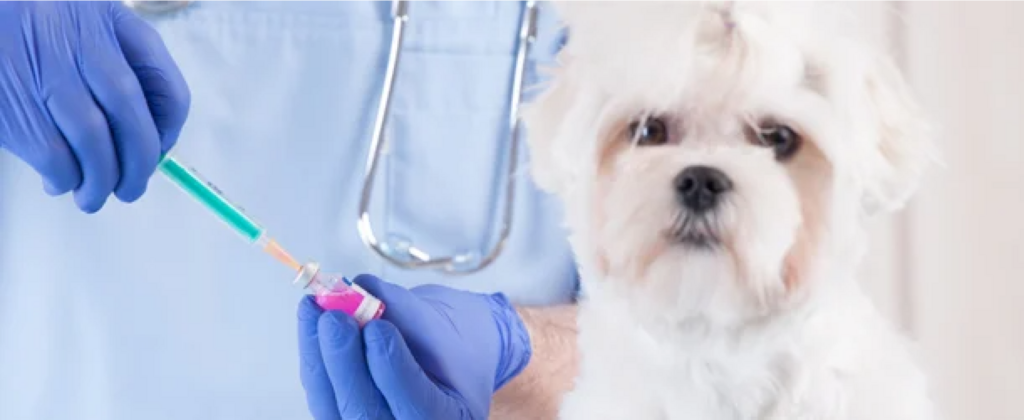
Typical vaccinations for puppies involve 3 injections spaced approximately 4 weeks apart. These usually occur at 6-8 weeks of age, 12 weeks of age, and 16 weeks of age but can vary depending on your location and they type of vaccine your vet uses. Once the puppy series has been completed your dog will need yearly, or in some cases three yearly, vaccinations for life.
In general, dogs in Australia are routinely vaccinated against Canine Parvovirus, Canine Adenovirus (Infectious Hepatitis), Distemper and Kennel Cough (Canine Parainfluenza II +/- Bordatella bronchisepta). Additional vaccinations such as for Leptospirosis may be recommended in certain areas so consult with your local veterinarian for recommendations specific to your dog's needs.
Remember that vaccinations can take up to two weeks to have their full effect, so unless your vet has advised otherwise avoid taking your puppy out and about, particularly to dog parks, beaches and other dog hotspots until 2 weeks after they have had their final vaccination.
For more information, read through our guide to puppy vaccinations.
Worming for puppies
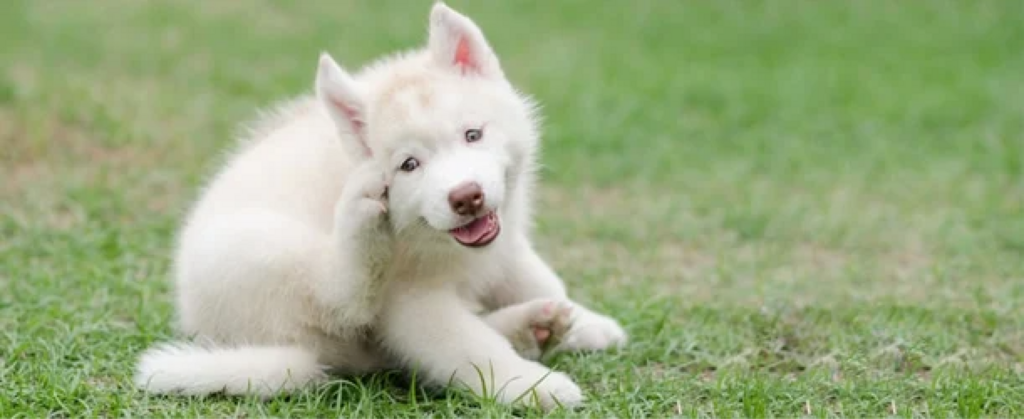
Intestinal worming
Heavy infestations with intestinal worms (roundworm, hookworm and whipworm) in puppies can be life threatening, so worming is an absolute must. Due to their smaller size and novel immune system, puppies are particularly sensitive to parasite infestations. Your pup's intestinal worming program should be started by the breeder, shelter, or pet store by 4 weeks of age.
How often should I worm my puppy?
It's recommended to worm your puppy every 2 weeks until 12 weeks of age and then monthly ongoing. Deworming schedule recommendations past 6 months of age do vary depending on who you speak to, and the risk factors in your dog's specific location and lifestyle. Our Vet Squad recommends monthly intestinal deworming against roundworms, hookworms and whipworms for dogs from 12 weeks of age onwards - this is the current gold standard of care for deworming protocols1,2,3.
Deworming at least every 3 months against tapeworm is recommended for all dogs from 12 weeks of age onwards.
More frequent deworming may be recommended by your vet in cases of heavy worm burdens, or where treatments only effective against adult worms are used.
Worming treatments may often be combined with monthly heartworm preventions for convenience.
For more information, read through some of our other articles: How often should I worm my puppy? and Worms in dogs.
Which wormer is best for my puppy?
When choosing a worming treatment for your puppy, check with your veterinarian regarding their best recommendations. Some areas of Australia have documented resistance in hookworm species to the active ingredient pyrantel, when used on its own. Intestinal wormers such as Drontal, which combine pyrantel and febantel or which use alternative active ingredients such as milbemycin oxime (Milbemax) are a safer choice in some circumstances.
Tapeworm
Tapeworm are long flat worms that live in the intestines, the two major species of tapeworms affecting pet dogs in Australia are the flea tapeworm (Diplylidium caninum) and hydatid tapeworm (Echinococcus granulosus).
The flea tapeworm is picked up by dogs who swallow infected fleas while grooming. Once infected with the tapeworm, the dog will pass tapeworm segments in his faeces. Sometimes these segments may stick to the hair around your dog's rear end causing them to bite, lick or scoot their bottom along the ground. Flea tapeworms are unlikely to cause serious illness in your dog and don't present a risk to humans but they do have a significant 'ick' factor and are usually a sign of poor flea control!
For dogs in urban areas who are not fed raw offal or allowed to consume animal carcasses, their risk of contracting Hydatid tapeworm is low. Dogs become infected by hydatid tapeworm by eating cysts present in uncooked offal or meat. Once the tapeworm reaches maturity in the intestines, it lays eggs which are passed with the dog's faeces. While uncommon, this tapeworm is important because if a human ingests one of these eggs, they can go on to develop potentially life-threatening hydatid cysts in their brain and other vital organs.
When worming your dog or puppy look for an allwormer which contains praziquantel (such as Drontal, Interceptor or Milbemax) to cover for tapeworm.
Want to know more? Read our Guide to Tapeworms in dogs
Heartworm
Heartworm prevention needs to be maintained for life. You can either choose to get a heartworm injection at your vet (usually given at 12 weeks, 6 months of age, and then every year), or you can give a monthly product yourself at home. Monthly products usually combine heartworm with intestinal worming, and some even combine flea and tick treatments in the mix too!
Interceptor or Milbemax are popular heartworm treatment options which also include intestinal worming and tapeworm coverage. If you want to combine with flea treatment, some excellent puppy products include Advocate, Revolution, or Sentinel Spectrum. Finally, if you want to combine flea, worming and heartworm as well as tick protection, take a look at Nexgard Spectra or Simparica Trio.
As there are many options and loads of different combinations it may be best to have a chat with your vet or ask a Pet Circle vet for more advice about which products to give your puppy.
Want to know more? Read Heartworm Facts Every Pet Owner Should Know.
Flea and tick treatment for puppies

Depending on the product, flea and tick prevention can be started around 6-9 weeks of age. As previously discussed, you can combine flea and tick protection with worming, or you might like to give two separate products.
Ask your vet about whether there are ticks, particularly paralysis ticks, in your area. Paralysis ticks are present along most of the east coast of Australia.
When is flea and tick season in Australia?
Depending on the product, flea and tick prevention can be started around 6-9 weeks of age. As previously discussed, you can combine flea and tick protection with worming, or you might like to give two separate products.
Ask your vet about whether there are ticks, particularly paralysis ticks, in your area. Paralysis ticks are present along most of the east coast of Australia.
When is flea and tick season in Australia?
Fleas and ticks are most active in warm tropical and subtropical areas, particularly during spring and summer. In some areas of Queensland and New South Wales is not uncommon for cases of tick paralysis to be seen year round. While the need for tick prevention may be seasonal in your area, we recommend that flea prevention is used year round to prevent flea eggs, larvae and pupae building up in the environment. This helps to avoid the sudden 'explosion' in flea numbers that can be seen with the onset of spring.
Nexgard, Bravecto and Simparica combine flea and tick prevention and are safe for puppies from 8 weeks of age.
Want to find out more about ticks and fleas? See our articles:
Desexing a dog
The average age that vets recommend desexing is at around 6 months. For large breed dogs greater than 20kg, there has been evidence to suggest that delaying desexing until maturity, over 12 months of age, may help protect against certain medical conditions. In some cases puppies can be desexed as early as 8 to 16 weeks. RSPCA Australia supports early age desexing as an effective way to reduce unwanted pregnancies and rehome dogs as soon as possible.
Desexing your puppy before he or she reaches sexual maturity (from 4 to 6 months of age) will prevent unwanted pregnancies as well as reducing roaming behaviour and territorial marking. Not only that, female dogs who are desexed before their second heat have a significantly reduced risk of mammary cancer and uterine infection. Male dogs who are desexed are less likely to experience prostate problems and are not affected by testicular cancers.
It is important when considering the time of desexing that you talk to your vet and weigh up the pros and cons.
Want to know more? Read our article: Everthing You Need to Know About Desexing
Puppy teething

It's never too early to start thinking about your puppy's dental health!
Your puppy will start teething from about 12 weeks as their adult teeth start to come through. Most of the time owners don't even notice these baby teeth fall out as they are often swallowed, but don't be worried if you find the occasional little tooth around the house!
While they are teething your pup will probably start to chew on everything, so make sure you give them plenty of appropriate chew toys to save your shoes and furniture. Until your pup has all their adult teeth avoid giving harder dental chews or bones as baby teeth are a little more delicate and may break if they chew hard objects. For more information on how to stop your puppy chewing, biting and mouthing, check out our Puppy Training Guide
Once all your pup's adult teeth are through (usually by about 6 months), it's time to start thinking about how you will care for their dental health throughout their life. Veterinary dentists recommend daily tooth brushing as the gold standard for dog dental care, and the earlier you start the easier it will be for your dog to accept this. Try to get your puppy used to having their mouth examined and handled from an early age.
Want to know more? Read Dental Care for Puppies and Puppy Dental Problems.
Pet Insurance

There are heaps of options for pet insurance out there these days, and they can be a fantastic way to ease the financial stress of an expensive, unexpected illness or injury such as cruciate ligament rupture, snake bite or cancer.
It pays to do your research before you sign up for a pet insurance policy, as not all are created equal. Be aware that some policies may exclude certain common conditions (such as cruciate ligament rupture) or limit the benefit paid in some circumstances (for example, tick paralysis).
One big issue with pet insurance is pre existing conditions; most if not all pet insurance providers will exclude the majority of pre existing health conditions for life. This means that if you take out your policy after your dog has been diagnosed with a problem, for example allergic skin disease, you will never be able to claim treatment for this condition on your pet insurance. On top of this, pet insurance companies can and do increase your premiums as your pet ages, and if your pet has been diagnosed with any medical conditions with your current insurer, any new insurer will see these conditions as pre existing and may well not cover them. Some companies can also refuse to continue cover for dogs once they reach a certain age!
So is pet insurance worth it?
From a vet's perspective, in some cases, sure. I have seen pet insurance deliver the best value for money for young puppies when the policy has been taken out before any accident or illness has occurred. Puppies have a way of getting into mischief and a pet insurance policy will go a long way when faced with a hospital bill in the thousands for a pup who has been hit by a car.
The bottom line here is to research and compare lots of different policies to see which would work best for you. Ideally do this before you even get your puppy so you know where you stand!
One alternative approach to pet insurance that some owners prefer is to set up a pet savings account and arrange for a small amount to be put aside from each pay cheque to cover any unexpected vet expenses.

At Pet Circle Insurance - we want to be clear about what's included and what's not. Don't be caught out by limits and exclusions of other policies - we have no sub-limits and an annual excess, so your puppy is covered up to the full value of your policy.
Learn more about our award winning insurance for all puppy breeds.
Dog Genetic Testing

In recent years genetic testing for dogs has become available to identify breed as well as to screen for a number of known genetic health conditions including progressive retinal atrophy, ivermectin sensitivity and dilated cardiomyopathy. When used and interpreted correctly genetic tests can give owners some really valuable information about their dog's individual health risks.
In order to identify the best genetic testing option for your pet consult your veterinarian or ask a pet circle vet.
Disease screening and pet insurance - before you decide to screen your pet for risk of certain diseases, make sure you have checked with your pet insurance provider regarding how any positive results may affect your current or future coverage.
Emergencies and what to do if your puppy is sick

Just like children puppies will get up to all sorts of mischief and can injure themselves in ways you could never imagine. It pays to be extra vigilant with your pup and supervise them closely to help keep them out of trouble.
Some common causes of injury or illness in puppies include chewing power cables, obstruction of the digestive tract with swallowed objects (toys, socks, underwear, door stops etc.), tummy upsets from dining out on the garbage bin, drowning in swimming pools, chewing on toxic plants and poisonings from eating toxic items such as chocolate, rat poison and snail baits. Just as you would with a human child, try as much as possible to restrict your pup's access to potential dangers.
Common infectious diseases in puppies include Parvovirus, Hookworm infection, and Demodex mites.
If your pup appears lethargic, off their food, has vomiting or diarrhoea or you suspect they may have eaten something they shouldn't have, contact your local vet or after hours emergency centre as soon as possible. In many cases early treatment offers the most successful outcomes. Keep your vet and their recommended after hours service's phone numbers on the fridge or in your phone so you can access them quickly when you need them.
Puppy Food
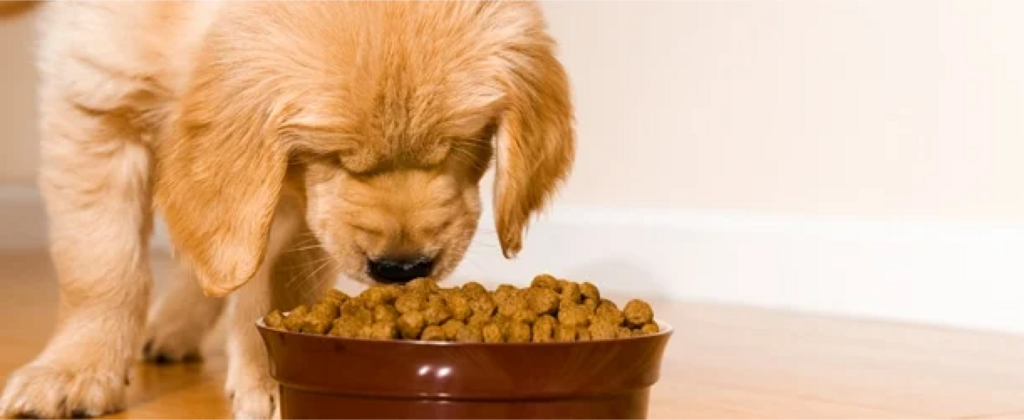
When can puppies start to eat solid food?
Puppies gradually wean off their mother's milk and begin to be able to eat solid food from about 8 weeks of age, so this is considered the minimum acceptable age for them to removed from their mother.
What your puppy eats in the first year of life has a direct effect on their growth, skeletal development and immune system. It also influences their risk of developing obesity later in life. Puppy food has the right balance of energy, protein, fat, calcium and phosphorus to help your puppy develop properly, it is also highly digestible which is good for sensitive stomachs. Depending on your puppy's breed and size they will need to stay on puppy food from 10 to 24 months of age.
What is the best puppy food?
Puppies need special food to support their increased need for energy, calcium and other nutrients during growth. Feeding your pup a high quality puppy food in their first year of life will set them up for a healthy life. Look for premium diets based on scientific research and development from brands including Hill's Science Diet, Royal Canin, Pro Plan and Advance.
Science based puppy foods are rigorously tested to ensure safety, quality, nutritional soundness, palatability and digestibility. The end result is food that tastes great, is gentle on your pup's tummy and delivers everything they need to grow and thrive.
The most convenient and economical means of feeding your dog is with dry food, although many owners like to offer a little wet food as a treat or to aid hydration. The choice of whether to feed wet food, dry food or a combination ultimately comes down to you!
Royal Canin have a range of breed specific puppy foods, with diets formulated specifically for the needs of popular breeds including Labradors, Golden Retrievers, German Shepherds and Pugs.
For more information, read through: What is the Best Dry Food for Puppies? and What is the Best Wet Food for Puppies?.
Toy and small breed puppy food
Small and toy breed puppies (those with an expected adult weight under 10kg) mature faster than medium and large breeds, so choose tailored small breed formulas to ensure your pup's unique nutritional needs are met.
Medium breed puppy food
Medium sized dogs have an adult weight of between 10 and 25kg and include popular breeds such as the Staffordshire Bull Terrier, German Shorthaired Pointer, Border Collie and Kelpie. Medium breed puppy foods are catered to your growing pup's energy requirements and include extra nutrition to support healthy digestion, brain development and a shiny coat.
Large and giant breed puppy food
Large and giant breed puppy diets have been formulated to account for the rapid growth rate and heavier body weight that is placed on their growing skeletons.
The main difference between a regular puppy food and a large or giant breed puppy food is the energy density, calcium content, and the calcium to phosphorus ratio.
Large and giant breed puppy diets are less energy dense to reduce the risk of overfeeding, because an overweight body condition is an important risk factor for the development of orthopaedic disease. These diets typically also have an appropriate balance of calcium and phosphorus with a lower overall calcium content than a regular puppy diet.
How much should I feed my puppy?
Puppies need to eat more frequently than adult dogs, after all they only have tiny little stomachs! Up until the age of about 5 to 6 months it's recommended to split your puppy's daily feeding amount into 3 separate meals.
Knowing how much to feed of a particular food can be tricky; the ideal feeding amount will vary from formula to formula and depends on your puppy's age and weight. To work out how much to feed your puppy, consult the feeding guidelines on the food packaging and use this as a starting point, adjusting the amount up or down depending on your puppy's needs. If you need help or aren't sure how much to feed, check with your veterinarian or ask a pet circle vet.
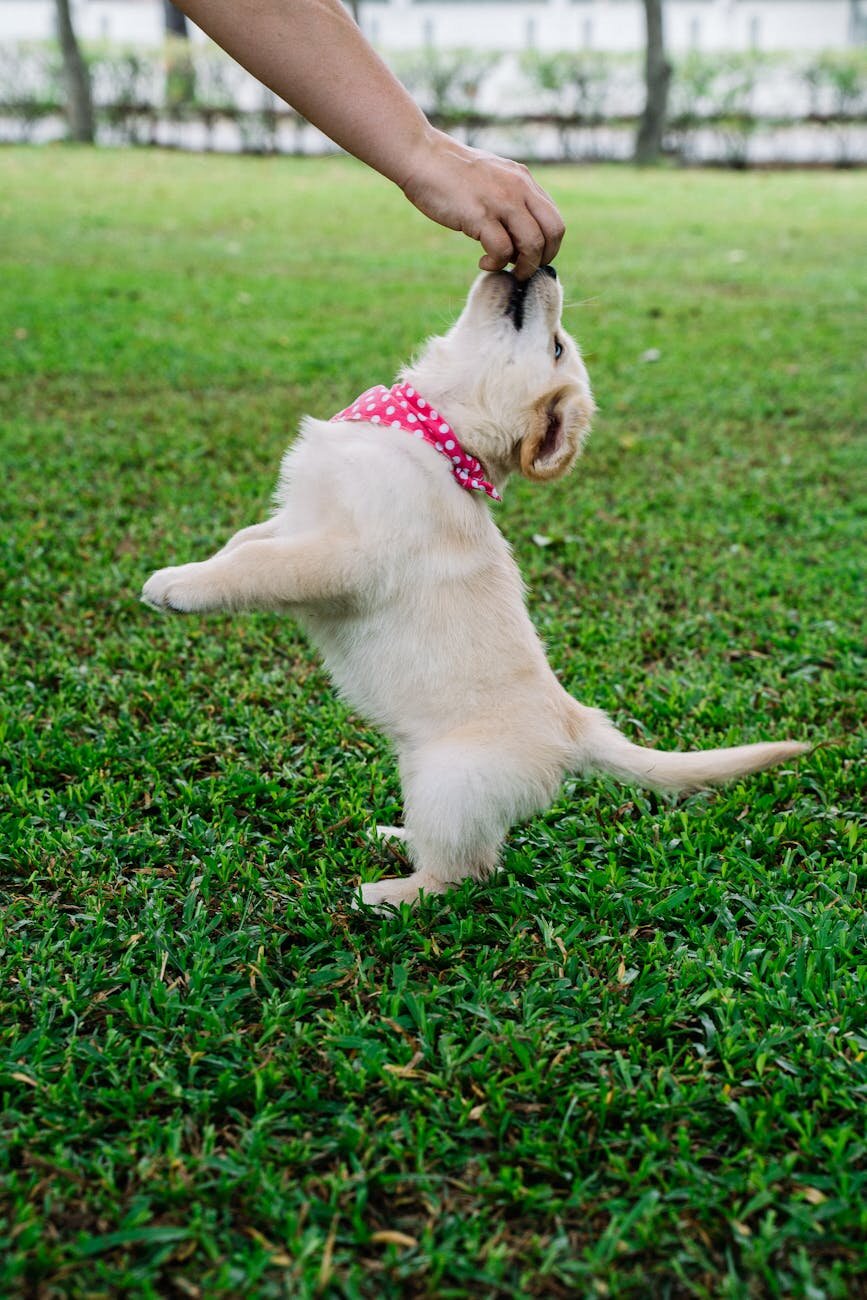
Any puppy parent knows they will need a stash of treats on hand to help with training and to reward good behaviour, but how do you choose the best treat for your pup?
Puppy Safe Treats
Any puppy parent knows they will need a stash of treats on hand to help with training and to reward good behaviour, but how do you choose the best treat for your pup?
Treats to avoid
Can my puppy eat bones?
Adult dogs may be fed raw bones (although there can be some risks involved), but avoid giving your puppy bones of any kind. Puppy teeth tend to be more fragile and can be damaged by chewing bones, plus young puppies have been known to inadvertently swallow chicken wings and other small bones whole!
What human foods are safe for dogs?
As a general rule, it is best to limit the amount of human food you feed your pup to help keep their diet balanced and prevent obesity in later life. In particular avoid feeding human foods which are known to be toxic to dogs including grapes, sultanas, chocolate, caffeine, macadamia nuts, avocado, garlic, onions and artificial sweeteners (xylitol).
Want to know more? Read Which Human Foods are Safe for Dogs and Which Foods are Dangerous for Dogs.
Puppy Grooming
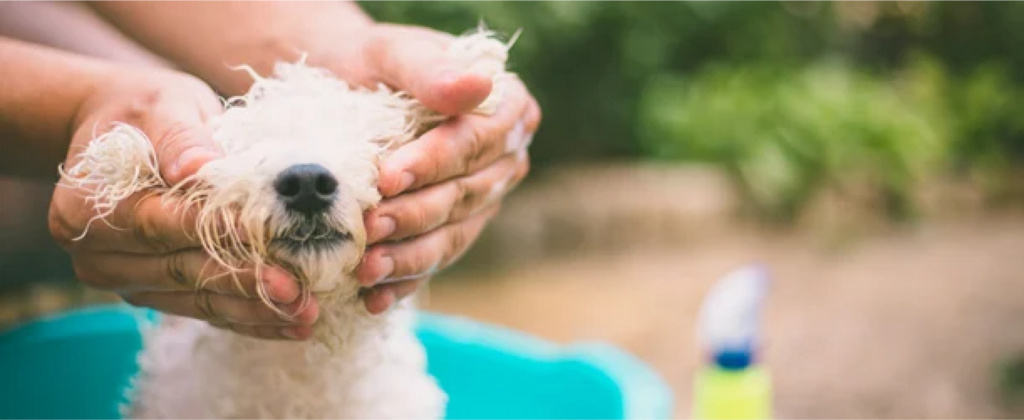
Puppies have a habit of getting dirty, so you'll need to keep some gentle shampoo on standby. As a general rule, aim to bathe your puppy about once every 2 weeks or so from the time you bring them home. Bathing your pup very frequently may dry out their skin which can cause itching or flaking. Look for a sensitive skin or puppy specific formula to help protect that soft skin and keep your pup's coat smooth and shiny. For quick clean ups in between washes you can also use pet cleansing wipes and coat refreshing sprays.
Read our Dog Grooming Guide.
Medium and long haired breed puppies will need to be brushed daily to prevent knots and matts from forming. They'll also need to get used to having their coats clipped to keep things neat and tidy. Start getting your puppy used to being groomed, handled and having their nails trimmed as soon as you bring them home; this will make life much easier for you and any dog groomers in the long run!
Want to know more? Read Choosing a Brush for Your Dog and How to Trim Your Dog's Nails.
Puppy Training

Positive pet parenting
Positive or reward based behavioural training is widely accepted to be the most effective and enjoyable way to encourage dogs to behave in the ways that we want. This concept really hinges on capturing and rewarding desirable behaviours (with treats and praise) while ignoring undesirable ones.
Contrary to popular belief, attempting to stop unwanted behaviours by yelling, picking up or interacting with your dog in any way can actually encourage them; your dog may well see any form of attention as positive reinforcement. Of course the use of physical force such as hitting, kicking or smacking is also not considered an appropriate or humane way to train a dog.
In the case of negative behaviours with dogs and puppies, the best approach is to 'shape' their behaviour by redirecting them away from the undesirable behaviour (eg. barking at the neighbours) towards a learned desirable behaviour (eg. sitting quietly on a mat). While it can take time and patience, positive pet parenting will help your dog to learn how to behave and interact with people and other animals appropriately without damaging your relationship or causing distress, anxiety or pain.
A handy mantra for positive pet parenting is to train the dog you want - acknowledge and reward behaviours you desire in your dog, ignore and reshape the behaviours that you don't desire.
Puppy Toilet training

The key to successful toilet training is consistency and patience. You will need to take your puppy outside to the area where you would prefer them to toilet a lot, ideally every 2 hours for young pups! A good rule of thumb is to take your pup to the toilet whenever they wake up from a nap, after eating or drinking, after play sessions or if they are showing signs that they need to go such as sniffing around the ground in circles.
When you take your pup out to the toilet, avoid the temptation to play with them, simply give a command like 'go wee' and wait patiently for a few minutes. Reward your puppy with plenty of praise every time they do the right thing. Remember that you'll need to get up during the night too in the early months to avoid any accidents in the house. I told you this would be hard work!
When (not if) your pup has a toilet training accident in the house, don't scold them or rub their nose in it as this will only breed anxiety and fear. Simply clean up the mess without delay, using an enzymatic cleaner to avoid the urine or faeces scent from attracting your puppy back to that spot to toilet next time. For more information, see our guide on toilet training your puppy.
How to stop a puppy from chewing on everything
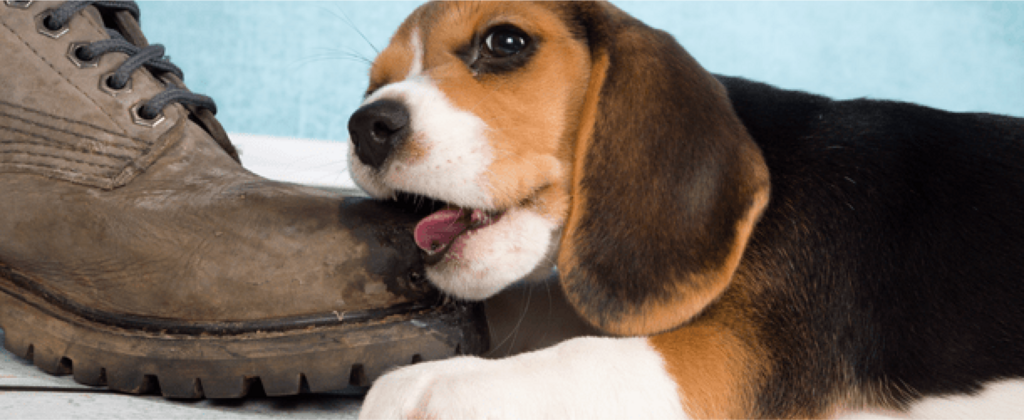
There's no two ways about it, puppies love to chew and it is likely that you will lose at least a couple of beloved shoes to your furry little chew monster. Chewing is a normal behaviour for puppies and adult dogs, so if you don't provide an appropriate outlet, like chew toys, your pup is likely to go looking for something else around the house to satisfy their urges.
To discourage problem chewing in dogs and puppies try to redirect their chewing to a chew toy, offering lots of praise when they do the right thing! Have a selection of different chew toys on hand that you can rotate every few days to keep your pup from getting bored. If your dog doesn't seem interested in the toys, sometimes a little KONG Easy Treat, natural peanut butter or vegemite can get their attention.
You can also use chew deterrent sprays for problem chewers, but bear in mind while these sprays may deter your dog from chewing a particular object, you still need to address the underlying behaviour. In adult dogs destructive chewing is usually motivated by boredom or lack of appropriate chewing alternatives. Giving your puppy lots of toys to stimulate their mind will help keep them out of mischief, it's also a lot easier than spraying everything in the house with chew deterrent spray!
Want to know more? Check out: How to Stop Your Dog from Chewing Everything, How to Choose Toys for Your New Puppy and Heavy Duty Dog Toys for Power Chewers.
How to stop a puppy biting

Biting and mouthing behaviour in puppies is very common. While it can be cute and tolerable to be 'mauled' by a 10kg puppy, I can guarantee it's not so appealing in a fully grown 30kg adult! So how can you nip this undesirable behaviour in the bud? (pun intended)
In the early months of life your puppy is still learning how to socialise and interact appropriately with other dogs and humans. Redirecting mouthing or biting by providing appropriate chew toys is one strategy to help limit this behaviour. If your puppy starts to chew on your hands while you are playing, redirect his or her attention to a toy, rewarding with lots of quiet praise if they start to play with it. Keep in mind that as your puppy gets very excited, he or she is more likely to start biting and mouthing again so keep play sessions short.
You may also need to teach your puppy bite inhibition. This essentially involves teaching them that humans don't like to be bitten. To do this, when your pup starts to bite or nip immediately remove your attention from them by standing up and walking away for a minute. In order for this to work everyone in the household needs to be consistent, so that your puppy learns biting results in playtime being over and attention being withdrawn. It is important to avoid yelling at or smacking puppies when they bite, as this can result in fear and anxiety that may cause other behavioural problems to appear.
Read more in How to Stop Your Puppy from Biting and Nipping.
Dog obedience training
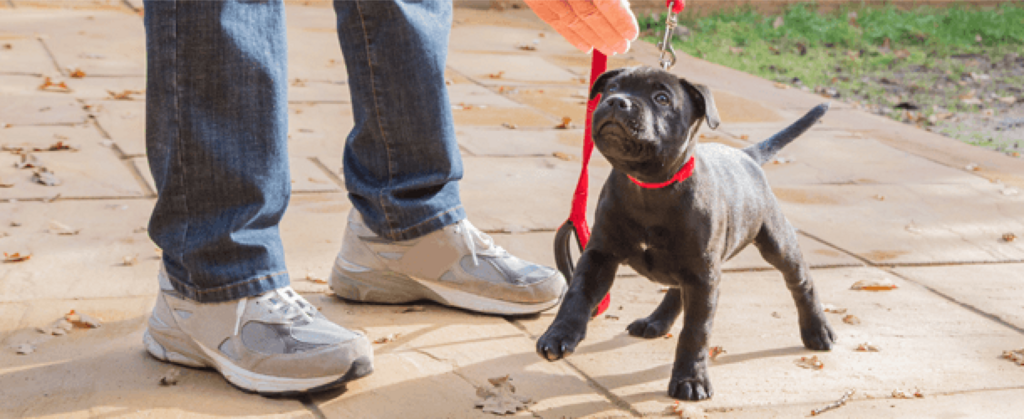
Your puppy can start to learn basic commands and manners as soon as he or she comes home. Putting in the hours now will potentially save you a lot of heartache later on. Obedience training is about more than just making your dog do things on command; it provides mental stimulation, strengthens the human animal bond and can be used to redirect your dog's focus from undesirable behaviours.
Ready to get started?
Crate Training

Crate training is a way to create a safe, personal space for your dog in your home. It draws on your dog's natural instincts to create a den, a safe refuge in which to sleep and hide. Although adult dogs may be able to be crate trained, the ideal time to start is when your dog is a puppy.
Crate training offers a lot of practical benefits and can be particularly useful with puppies as an aid to toilet training and preventing destructive or undesirable behaviours.
Want to know more? Read How to Crate Train Your Puppy.
Clicker Training

Clicker training is a way of signalling desirable behaviour to your dog in order to 'capture' it and can help to accelerate training. A good way to think of the clicker is like a camera that takes a picture of the desired behaviour at the instant it occurs. The clicker is paired with positive reinforcement (usually treats) to reinforce and teach the behaviour.
Want to know more? Read Clicker Training Your Dog.

The first 14 to 16 weeks of your puppy's life is when they will be most open to new experiences and is often referred to as the 'socialisation window'. Socialising your puppy involves exposing them to lots of different environments, things, people and animals in a positive and safe way to help them have the best chance of being well adjusted canine citizens.
As this window coincides with the period of time in which your puppy may not have full immunity and protection from their vaccinations, it's crucial to choose the location of any socialisation very wisely. This is particularly important for avoiding parvovirus, which still kills plenty of puppies in Australia every year.
Socialising your puppy effectively is more than just chucking them in the deep end at the dog park! Negative experiences at any time during their development can stick with a puppy well into adulthood, so being beaten up by the local dog park bully is not going to help your puppy play well with others later on.
To socialise your pup, get in touch with your local vet or dog trainer about puppy preschool classes. Puppy preschool offers a safe, supervised environment where your puppy can meet and play with other pups (and usually learn a few basic obedience skills and healthcare tips too!). If you have friends or family members with healthy, fully vaccinated, well socialised dogs you could also ask them to come around for a puppy playdate, just be sure to keep an eye on things to make sure the play doesn't get out of hand. Puppies learn their social skills by 14 weeks of age therefore it is important to be involved and help your pup to reach their full potential. Find a Delta-accredited positive reinforcement dog trainer here.
As well as other dogs, try to expose your puppy to as many different people (including the postie and tradesmen and women in uniform), sounds (such as the vacuum cleaner or thunder) in a calm, friendly and non overwhelming environment as you can during this socialisation window.
Another hot tip is to use an Adaptil Junior Collar during the critical socialisation window. Adaptil contains a synthetic form of DAP (Dog Appeasing Pheromone). Female dogs release DAP soon after birth to establish feelings of well-being and attachment in their puppies. Adaptil Junior is the only registered product in Australia with supporting evidence on having a positive impact on a pup's socialisation. In one study4, 8-15 week old puppies who wore an Adaptil Junior Collar for 8 weeks were compared to placebo groups of puppies who did not have exposure to a DAP-containing collar. In puppy classes, the pups who wore the Adaptil collar were found to have:
- Reduced anxiety and fear
- Reduced excitability
- Longer and more positive interactions with other puppies
In follow up data, they were also found to be better socialised and adapted faster in new situations and environments compared with puppies who did not wear the collar. Adaptil Junior also helps puppies cope better with separation and be more likely to sleep through the night.
Want to know more? Read The Importance of Socialisation.
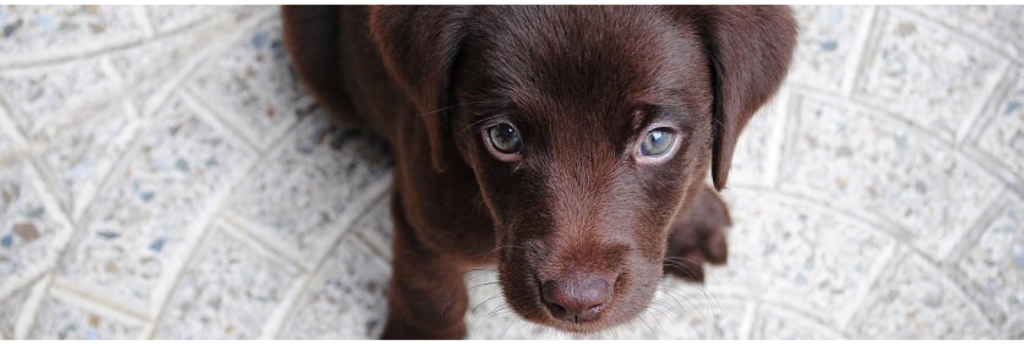
Bringing a new puppy home and the first few months of puppyhood are something to be enjoyed because they grow up quickly! With a little guidance, knowledge, preparation, patience, and by ensuring you have the essentials, you can set your pup up for many happy years as a loved and cherished family member.
"Before you get a dog, you can't quite imagine what living with one might be like; afterward, you can't imagine living any other way." - Caroline Knapp
References
Tropical Council for Companion Animal Parasites Guidelines for the Diagnosis, Treatment and Control of Canine Endoparasites in the Tropics https://www.troccap.com/2017press/wp-content/uploads/2019/05/TroCCAP_Canine_Endo_Guidelines_English_Ver2.pdf (2019) (accessed October 5, 2023)
Luca Massetti, Rebecca J. Traub, Louise Rae, Vito Colella, Lara Marwedel, Phillip McDonagh, Anke Wiethoelter. One Health Volume 17, December 2023, 100587: Canine gastrointestinal parasites perceptions, practices, and behaviours: A survey of dog owners in Australia. https://www.sciencedirect.com/science/article/pii/S2352771423001076#bb0100 (accessed October 5,2023).
Companion Animal Parasite Council, General Guidelines for Dogs and Cats (2023), https://capcvet.org/ (accessed October 5, 2023).
Denenberg S, Landsberg GM. Effects of dog-appeasing pheromones on anxiety and fear in puppies during training and on long-term socialization. J Am Vet Med Assoc. 2008 Dec 15;233(12):1874-82. doi: 10.2460/javma.233.12.1874. PMID: 19072600.
History
Our experts continually monitor the health and wellness space and we update our articles when new information becomes available.
Fri Feb 14 2025
Edited by Dr Teagan Lever BVSc (Hons)Dr Teagan Lever BVSc (Hons)
Head Veterinarian, BVSc (Hons)
Pet Circle's Head Veterinarian, Dr Teagan graduated from the University of Queensland in 2010 and went on to work in small animal and mixed practice in various locations around QLD & ACT before joining Pet Circle in early 2016. Dr Teagan has special interests in dermatology, nutrition and preventative health care. She feels privileged to witness the special bond people share with their pets on a daily basis and enjoys forming lasting relationships with pet parents and their fur children.


Socialisation